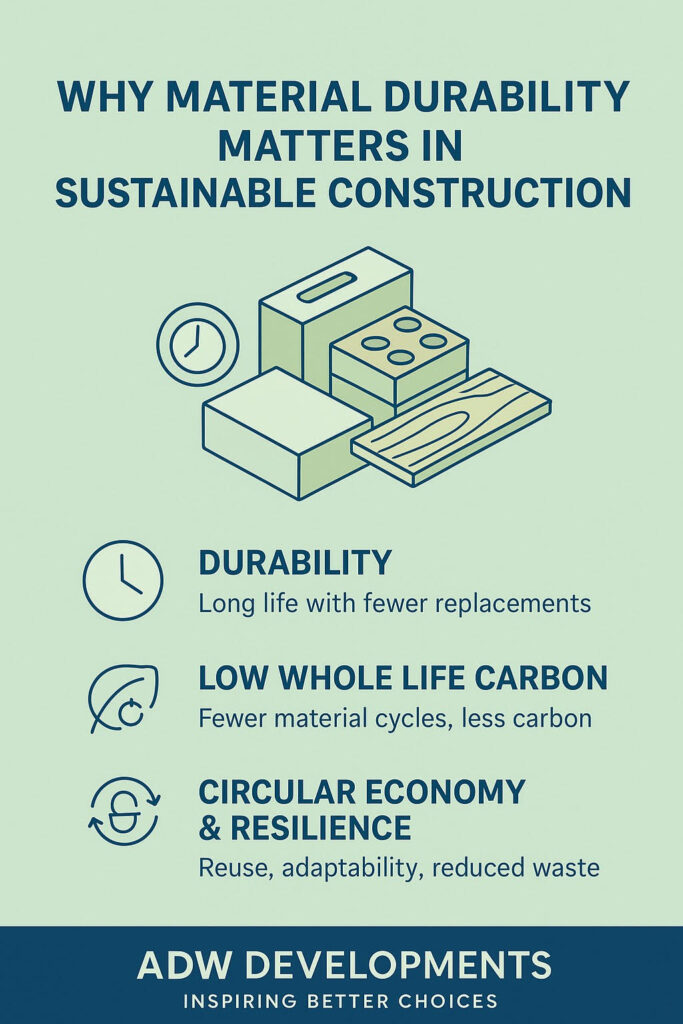In our Knowledge Share, we have already discussed Material Adaptability in Sustainable Construction and The Importance of Durability and Resilience in Construction, and today, we will explore the crucial role of material durability.
A sustainable built environment relies on structures that last. In short, it is a material’s capacity to resist environmental stresses without degrading, ensuring buildings remain reliable for generations.
This article outlines why durability matters in construction, examining the factors that influence material choice, advances in material science, and the long-term value of investing in durable solutions. It also highlights how durability underpins sustainable practice and provides guidance for professionals seeking to build a resilient future.

What is Material Durability and Why Does it Matter?
Material durability is more than just a technical specification; it is a strategic imperative for any construction project. It defines a material’s capacity to resist deterioration and maintain its intended properties when exposed to various environmental factors and operational demands over time.
These factors can include:
- Climate: Temperature fluctuations, humidity, rainfall, and UV radiation.
- Moisture levels: Exposure to water, condensation, and freeze–thaw cycles.
- Chemical exposure: Contact with corrosive substances, pollutants, or de-icing salts.
- Mechanical stresses: Loads, vibrations, and abrasion.
- Biological agents: Fungi, insects, and other organisms.
By prioritising durability, structures remain functional, safe, and aesthetically pleasing throughout their intended lifespan. Conversely, a lack of durability can result in premature failure, costly repairs, increased maintenance, and a considerable environmental footprint due to frequent replacements and associated resource use. Ultimately, durable materials contribute directly to the longevity and resilience of the built environment.
The Role of Material Durability in Sustainable Construction
The connection between material durability and sustainable construction is profound. While durable materials may sometimes have higher upfront costs, they nonetheless offer substantial long-term benefits:
- Reduced resource consumption: Longer-lasting materials require fewer replacements, conserving raw materials and reducing the energy expended in extraction, processing, and transportation.
- Minimised waste generation: By extending the service life of components and structures, durable materials significantly reduce construction and demolition waste, lessening pressure on landfills.
- Lower life cycle environmental impact: Fewer replacements equate to a reduced embodied carbon footprint over a building’s lifespan, avoiding the emissions linked to manufacturing and transport.
- Enhanced economic viability: Reduced maintenance and repair costs, coupled with longer functional life, provide significant savings, making durable construction financially sound.
- Improved social impact: Durable structures contribute to safer, more reliable infrastructure, enhancing the quality of life for occupants and communities.
Moreover, in the context of Whole Life Carbon, durability plays a crucial role in minimising a building’s footprint. By reducing the need for replacement, we directly cut embodied carbon as well as the operational emissions linked to installation and upkeep.
Building a More Resilient Future
The field of material science is continuously evolving, offering innovative solutions that significantly enhance the durability and performance of construction materials. Importantly, these advancements are crucial for addressing both climate change and resource scarcity.
For example:
- High-Performance Concrete (HPC): Using specialised admixtures and supplementary cementitious materials (SCMs), HPC achieves superior strength, reduced permeability, and resilience against stresses such as chemical attack and freeze–thaw cycles, greatly extending service life.
- Fibre-Reinforced Polymers (FRPs): These lightweight composites, made from high-strength fibres within a polymer matrix, provide exceptional strength-to-weight ratios and corrosion resistance. As a result, they are increasingly replacing traditional materials such as steel in demanding environments.
- Self-healing materials: Emerging technologies now explore concrete with bacteria that produce limestone to fill cracks, or polymers with embedded capsules releasing healing agents upon damage. Though still developing, these materials hold immense promise for extending lifespans and reducing maintenance.
- Advanced coatings and surface treatments: Protective coatings and treatments can significantly enhance durability by shielding materials from moisture, corrosion, and abrasion.
Consequently, these breakthroughs empower engineers and architects to design buildings that are both resource-efficient and resilient against environmental challenges. By embracing such innovations, the construction sector can drive a future defined by enhanced durability and sustainability.
FAQs
What is material durability in construction?
Material durability is a material’s ability to resist environmental stresses over time without significant degradation, thereby ensuring long-term performance, safety, and reliability.
Why is material durability important for sustainable construction?
Durable materials reduce replacements, conserve resources, minimise waste, lower embodied carbon, and cut maintenance costs, supporting sustainable practice.
What factors influence the selection of durable materials?
Climate, moisture, temperature shifts, chemical exposure, mechanical stresses, and biological agents all play a role. A thorough understanding of these helps ensure the right choice.
Can durable materials be more expensive upfront?
Yes, but they typically offer long-term benefits including lower maintenance, fewer repairs, and resource savings—making them cost-effective over a project’s lifespan.
What are some examples of advancements in durable materials?
High-performance concrete, fibre-reinforced polymers, self-healing materials, and advanced protective coatings all represent important innovations.
Prioritising Durability for a Sustainable Legacy
As showcased, durability is not a detail but a defining principle of sustainable construction. By embedding it into material choices and design, and by embracing advances in material science, we can reduce environmental impact, extend building lifespans, and secure long-term value. The future of resilient, efficient infrastructure depends on treating durability as a foundation, not an afterthought.
